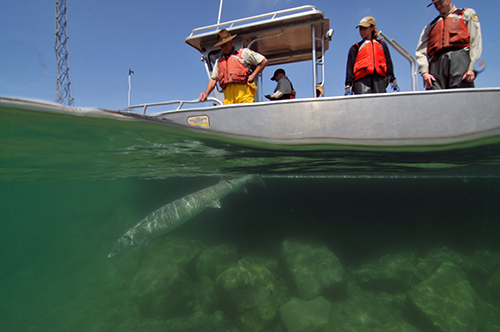Water Quality
The suitability or quality of water to support reproduction, growth, and survival of fishes is an essential component of fish habitat. Pure water alone will not support fish production. Water must have suitable physical (e.g., temperature), chemical (e.g., pH, minerals, dissolved oxygen, contaminants), and biological (e.g., chlorophyll) characteristics to fulfill the essential life requirements of fishes. Water transparency is affected by all of these characteristics and, in conjunction with specific parameters like water temperature, dissolved oxygen, and chlorophyll levels, is often considered by biologists as water quality features that best reflect fish habitat condition. Preferences for water quality features vary among fish species and among life stages for many species. Changes in water quality can affect key elements of fish production, such as egg survival and hatching rates, survival of fish larvae, feeding habits of juvenile and adult fish, and spawning behavior. Water quality can also  combined_SMALL.jpg) impact fish community composition and resiliency. Highly productive waters support different fish communities than waters of low productivity. Generally, highly productive waters favor fish communities comprised of catfishes, minnows, gizzard shad, and sunfishes, whereas waters with limited productivity support salmon, trout, whitefish, bloater, and cisco communities. Moderately productive waters are ideal for walleye, yellow perch, northern pike, and muskellunge communities. Water quality also is important for drinking, recreation, and other purposes, with other measures (such as algae, odor, toxins) used to assess condition.
impact fish community composition and resiliency. Highly productive waters support different fish communities than waters of low productivity. Generally, highly productive waters favor fish communities comprised of catfishes, minnows, gizzard shad, and sunfishes, whereas waters with limited productivity support salmon, trout, whitefish, bloater, and cisco communities. Moderately productive waters are ideal for walleye, yellow perch, northern pike, and muskellunge communities. Water quality also is important for drinking, recreation, and other purposes, with other measures (such as algae, odor, toxins) used to assess condition.
Management of water quality in the Great Lakes is overseen by federal, provincial, and state agencies in Canada and the United States. Ultimately, actions must occur at local levels to be effective. A formal Great Lakes Water Quality Agreement between the two federal governments was first signed in 1972 and most recently reaffirmed in 2012. The agreement calls for cooperative actions to restore, protect, and enhance water quality (specifically its chemical, physical, and biological integrity), that will promote ecological health in the Great Lakes basin. In lay terms, the agreement strives to provide water quality that will support all desired benefits to humans, including fish habitat for sustainable fisheries.

A Joint Strategic Plan for Management of Great Lakes Fisheries calls for lake committees to make effective use of water quality management by developing fish community objectives (FCOs) that identify the desired structure of the fish community in each lake and to identify environmental impediments to their achievement. FCOs have been in place for all lakes for more than 20 years. Several lake committees developed formal environmental objectives (EOs) that outline the environmental conditions needed to achieve their desired fish communities. Others accommodated environmental needs into their FCOs. The Council of Lake Committees formalized a set of environmental principles (EPs) in 2016 to help lake committees identify and act on priorities for protecting or improving habitats and water quality that support production of desired fish communities. Collectively, the FCOs, EOs, and EPs provide guidance for lake committees and agency fish managers to identify their fish habitat priorities for consideration in the decisions of water quality and land-use managers in the Great Lakes.

